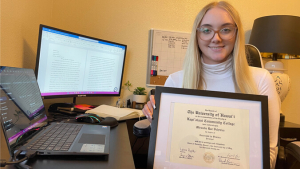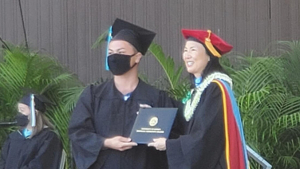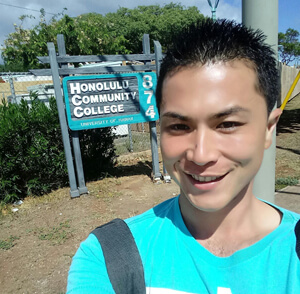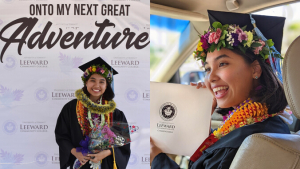University of Hawaiʻi at Mānoa senior Miranda Schreier, who also works as a paralegal, earned her associate’s degree from Kapiʻolani Community College in 2021. She said the Hawaiʻi Promise scholarship helped her to focus on her educational goals in the community college’s paralegal program, since she did not have to worry about money.

“That scholarship was a complete blessing for me,” Schreier said. “I was able to focus more on my studies and I just had a huge weight lifted off of my shoulders.”
UH is asking state lawmakers this legislative session to consider expanding Hawaiʻi Promise to the four-year institutions—UH Mānoa, UH Hilo and UH West Oʻahu by increasing annual funding by $19 million. House Bill 390 HD1, which expands the law to include the three campuses, was passed by the House of Representatives and crossed over to the Senate. The measure has to be scheduled for a hearing the week of March 20 or it will be considered dead in the 2023 legislative session.
Often referred to as a last-dollar scholarship, Hawaiʻi Promise is currently only available to qualified UH Community College students, covering their direct costs of education that are not covered by federal grants and other scholarships. The program started in fall 2017 and has helped 8,852 UH Community College students with financial need since, including 2,139 students during the 2021–22 academic year alone. UH awarded more than $4.88 million, supporting those students with tuition, books, supplies and transportation costs. Students must qualify for federal aid to qualify for the Hawaiʻi Promise scholarships.
Read more about the Hawaiʻi Promise Program
Almost two-thirds (60%) of Hawaiʻi Promise scholarships were awarded to underrepresented students, such as Native Hawaiians, Filipinos and Pacific Islanders—a higher share than the 52% of underrepresented students enrolled at the UH Community Colleges that year.
Improved performance
The fourth year of the state-funded Hawaiʻi Promise program also yielded impressive results:
- Hawaiʻi Promise recipients attempted and earned more credits than non-awardees. Hawaiʻi Promise recipients earned 15.8 credits on average compared to 11.7 credits on average for all degree-seeking students in academic year 2021–22.
- Hawaiʻi Promise recipients had higher passing rates than their peers and earned higher grades with Hawaiʻi Promise recipients earning an average 3.0 cumulative GPA compared to an average 2.8 cumulative GPA for non-Promise students in fall 2021.
- Full-time Hawaiʻi Promise recipients were more likely to continue to be enrolled at UH than non-awardees. In fall 2022, 69% of recipients were still enrolled, compared to 61% of non-awardees.
- Part-time Hawaiʻi Promise recipients returned at a higher rate than their peers—56% compared to 47%.
Based on these outcomes and the testimonies of scholarship recipients, UH is requesting an additional $3.7 million for the program this legislative session to help fund the increased demand for aid for students attending the seven UH community colleges across the state.
Investing in the future


It’s an initiative that Hawaiʻi Promise recipients fervently support.
“It is just a life saver,” Schreier said. “It’s a wonderful program that I really hope to see expanded.”
After graduating in the spring with a bachelor’s degree in English, Schreier plans to continue on to earn an MBA or law degree, or both.
“Even though I’m in my last semester at Mānoa, and my tuition is already paid for, this program can impact generations of students to come,” she said.
“I worried about whether or not I was going to have food for the night or food for month, and if I was going to be able to afford my rent, if I was going to be able to pay for my textbooks, what other things I would have to go ahead and pay for,” said Shane Shimabukuro, who received the scholarship while at Honolulu CC, and is now studying pre-business at UH Mānoa. “It has helped me, and I can only imagine the extent of the help that it could do for many other students—helping relieve the fear of economic insecurity.”
Lindsey Millerd is a junior majoring in Hawaiian and Indigenous health and healing at UH West Oʻahu. She received the Hawaiʻi Promise scholarship at Leeward CC, where she earned an associate’s degree in 2022.

“It was really helpful in just allowing me to focus on school, doing well in my classes, and not having to stress too much about paying or working to pay off my tuition at that time,” she said.
Millerd was recently appointed to the Honolulu Youth Commission and plans to go into a career related to community health.
In her view, “Hawaiʻi Promise is supporting Hawaiʻi’s future.”

